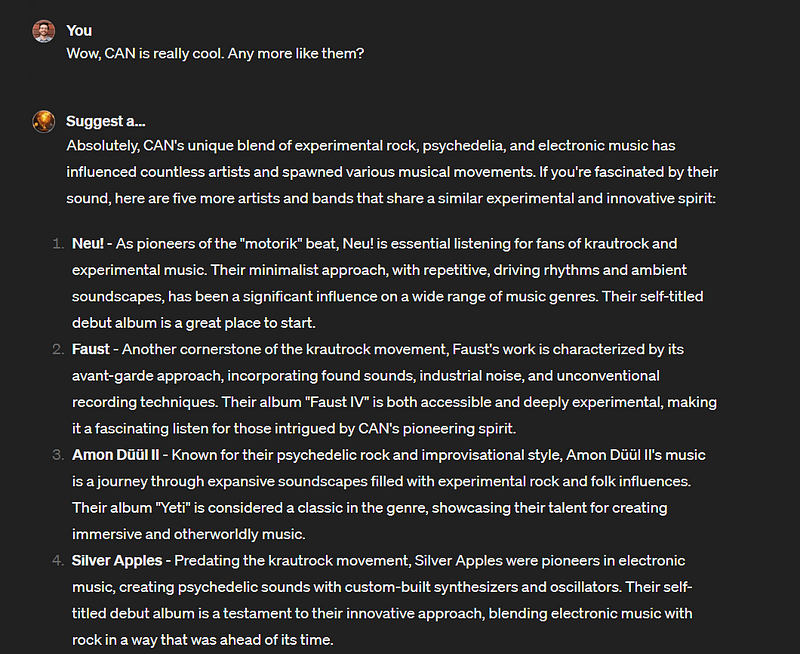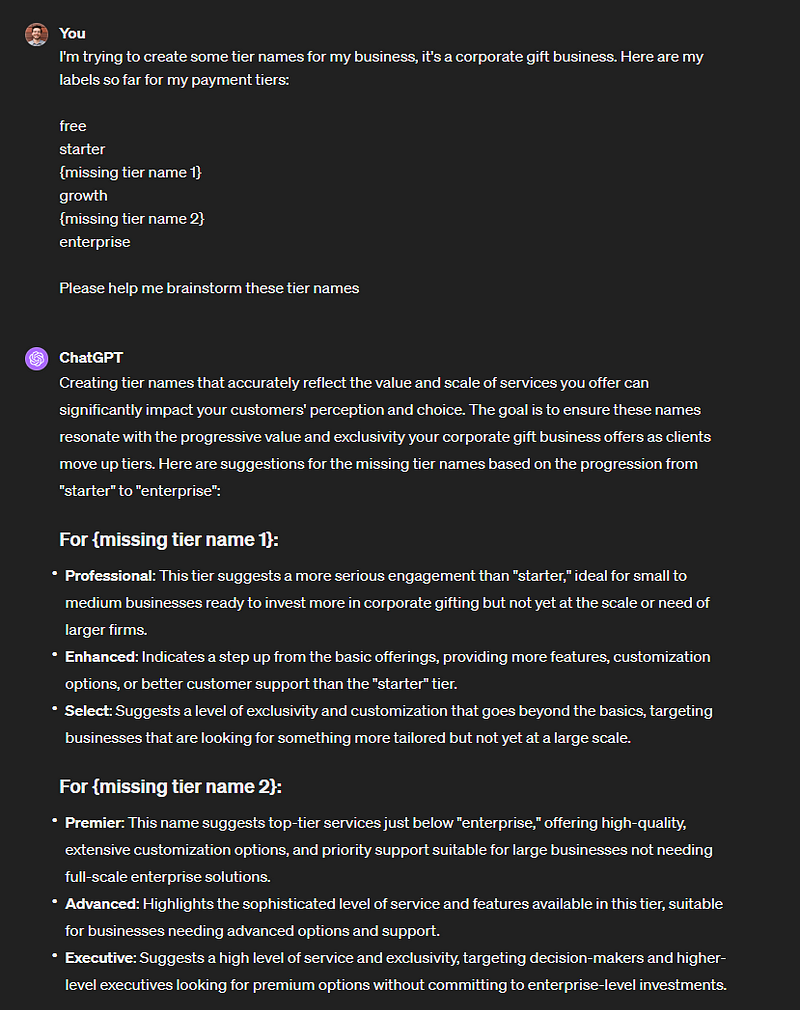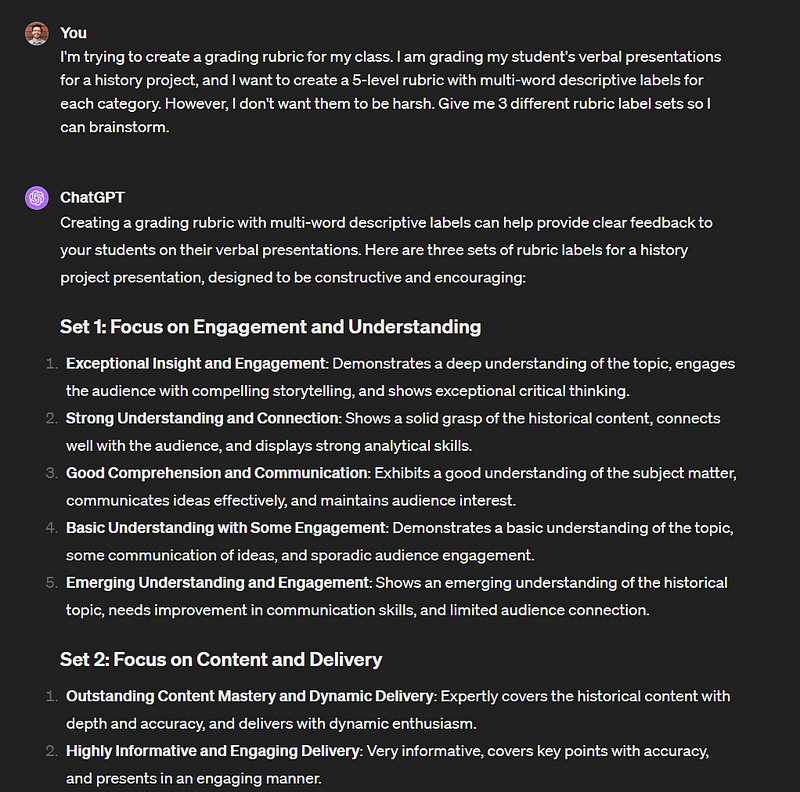Three Underrated ChatGPT Use Cases
Three of my favorite use cases for ChatGPT that I don’t see enough people using.

Some of the top use cases for ChatGPT include writing, coding, translating, research, and more. This quick article outlines some of my favorites for you that I don’t often see talked about.
1. Using ChatGPT as a name brainstormer (the right way)
If you’ve ever used ChatGPT to name things, you know that it’s actually quite bad out-of-the-box. See what I mean?

As you can see, a lot of these names are quite cheesy, contrived, and generic. However, if we know what we’re looking for, we can prompt ChatGPT in a much more intelligent way.
In fact, I used this very strategy to name my AI-interviewing startup Elevora (a combination of pseudo-Latin roots meaning “elevating voices”). Here’s how my process works:
Decide what type of name you want
In order for this process to work, you need to know what type of name you want. Here are some broad categories of names:
- Descriptive Names — These names are straightforward, matter-of-fact, and directly describe the product, service, or character they’re associated with. Examples: Safe Lock, Quick Print, Bright Light, etc.
- Symbolic Names — Symbolic names represent the concept in an indirect way, often invoking imagery, mythology, or deeper meanings. Examples: Phoenix, Athena, Wolfpack, etc.
- Portmanteau Names — Portmanteau names blend parts of two or more words or their sounds to create a new word. This just so happens to be ChatGPT’s favorite type, for better or worse. Examples: Netflix (internet + flicks), Groupon (group + coupon), etc.
- Abstract Names — Abstract names are invented words or phrases that don’t have a direct meaning in any language. These are easy to create because it’s likely that they don’t yet exist. Examples: Xerox, Elevora, Kodak, etc.
You also need to tell it what structure the name should have.
- Single word names
- Multi-word names
- Suffix names (i.e. [name] + Technologies, Legal, Farms, or some other label)
When you decide what type of name you want, paste a combination of the above category descriptions with your prompt, and you’ll see a dramatic increase in output quality. If you don’t want portmanteau names, sometimes you have to specify directly.

For my purposes, the above names are significantly better than my first try.
As a bonus, you can also improve the name output greatly by asking ChatGPT to ask you clarifying questions so it can gather more information for itself. Like I always say, the question trick always helps!
One last trick to try is to ask GPT for extreme volume. Ask it for 100 more names after your first prompt. You can iterate through this and do it several times. After 100s of unique names, there’s bound to be at least one that you’ll like!
2. Using ChatGPT as a recommender tool
ChatGPT is the ultimate associator.
What do I mean by that? Well, because of the very nature of its construction, ChatGPT is aware of and understands the deep semantic connections between not only concepts but also human constructs such as music, movies, hobbies, and others.
If ChatGPT really does have access to a nearly infinite repository of media and human constructs, why not use it as a recommender tool? That’s exactly what I do.
I am a serial new music addict. This means that no matter how much new music I digest, I always want more. Sometimes, I’m looking for a particular vibe, and ChatGPT can really help with that. Let me show you:

It’s so easy to start with a root, in this case, Radiohead, and spring off from there. You can develop these deep suggestion rabbit holes and end up finding music that you never even knew existed.

The best part is that this strategy works with movies, books, hobbies, art, and any other media that you can imagine. If you’re looking to enrich your life with new things, this is a great way to start.
For the above examples, I was using my “Suggest a…” GPT. You can use it for free here.
3. Using ChatGPT as a label manipulator
Have you ever found yourself trying to develop a framework or think through a complex system that requires labeling? If you have, you know that this can be quite a difficult task. It just so happens that ChatGPT is excellent for this!
Because ChatGPT is so good at manipulating the English language, it’s easy to use it to rearrange and synonymize text to create optimal labels or category names. This is best shown in action:

As you can see, it’s very helpful for filling gaps in categorical naming schemes. Here’s another example:

This is a quick and dirty way to create scales, rubrics, categories, spreadsheet headers, and more. It’s especially good when you use it in an iterative process or if you already have some of the labels decided.
I hope you have found these three use cases helpful. I have several more cool use cases that I will share in the future, so please let me know if you want to see more!
Thanks for reading.
-Jordan






